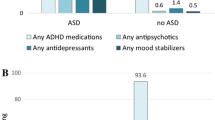Abstract
To date, there have been few surveys of psychotropic and antiepileptic drug (AED) prevalence in individuals with autism-spectrum conditions. We surveyed 747 families in the Autism Society of Ohio regarding the use of psychotropic drugs, AEDs, and over-the-counter (OTC) preparations for autism. In all, 417 families (55.8%) replied. A total of 45.6% were taking some form of psychotropic agent (including St. John's wort and melatonin), whereas 11.5% were taking AEDs, and 10.3% took OTC autism preparations. The most common psychotropic agents included antidepressants (21.6%), antipsychotics (14.9%), antihypertensives (12.5%), and stimulants (11.3%). Some 51.6% were prescribed psychotropic drugs or AEDs, and 55.4% took psychotropic drugs, AEDs, or autism supplements. Demographic variables frequently found to be associated with medication use included greater age, more severe autism, more severe intellectual handicap, and housing outside the family home. Whereas there is empirical support for the use of some of these psychotropic agents in autism, others are being prescribed with minimal research support. OTC autism preparations were used in substantial numbers of individuals, despite limited research support and the possibility of toxic effects.
Similar content being viewed by others
References
Aman, M. G. (1996). Stimulant drugs in the developmental disabilities revisited. Journal of Developmental and Physical Disabilities, 8, 347-365.
Aman, M. G., Arnold, L. E., & Armstrong, S. C. (1999). Review of serotonergic agents and perseverative behavior in patients with developmental disabilities. Mental Retardation and Developmental Disabilities Research Reviews, 5, 279-289.
Aman, M. G., & Langworthy, K. S. (2000). Pharmacotherapy for hyperactivity in children with autism and other pervasive developmental disorders. Journal of Autism and Developmental Disorders, 30, 451-459.
Aman, M. G., & Madrid, A. (1999). Atypical antipsychotics in persons with developmental disabilities. Mental Retardation and Developmental Disabilities Research Reviews, 5, 253-263.
Aman, M. G., Sarphare, G., & Burrow, W. (1995). Psychoactive drugs in group homes: Prevalence and relation to demographic/ psychiatric variables. American Journal on Mental Retardation, 99, 500-509.
Aman, M. G., Van Bourgondien, M. E., Wolford, P. C., & Sarphare, G. (1995). Psychotropic and anticonvulsant drugs in subjects with autism: Prevalence and patterns of use. Journal of the American Academy of Child and Adolescent Psychiatry, 34, 1672-1681.
Bates, W. J., Smeltzer, D. J., & Arnoczky, S. M. (1986). Appropriate and inappropriate use of psychotherapeutic medications for institutionalized mentally retarded persons. American Journal of Mental Deficiency, 90, 363-370.
Baumeister, A. A., Sevin, J. A., & King, B. H. (1998). Neuroleptic medications. In S. Reiss & M. G. Aman (Eds.), Psychotropic medication and developmental disabilities: The International Consensus handbook (pp. 133-150). Columbus, OH: The Ohio State University Nisonger Center.
Findling, R. L., Maxwell, K., Scotese-Wojitila, L., Huang, J., Yamashita, T., & Wiznitzer, M. (1997). High-dose pyridoxine and magnesium administration in children with autistic disorder: An absence of salutary effects in a double-blind, placebo-controlled study. Journal of Autism and Developmental Disorders, 27, 467-478.
Fraser, W. I., Ruedrich, S., Kerr, M., & Levitas, A. (1998). Beta-adrenergic blockers. In S. Reiss & M. G. Aman (Eds.), Psychotropic medications and developmental disabilities: The international consensus handbook (pp. 271-289). Columbus, OH: The Ohio State University Nisonger Center.
Hagerman, R., Bregman, J. D., & Tirosh, E. (1998). Clonidine. In S. R. Reiss & M. G. Aman (Eds.), Psychotropic medications and developmental disabilities: The international consensus handbook (pp. 259-270). Columbus, OH: The Ohio State University Nisonger Center.
Heberlein, T. A., & Baumgarner, R. (1978). Factors affecting response rates to mailed questionnaire: A quantitative analysis of the published literature. American Sociological Review, 43, 447-462.
Institute of Medicine (Food and Nutrition Board). (1998). National Academy of Sciences. Washington, DC: National Academy Press.
Kerlinger, F. N., & Lee, H. B. (2000). Survey Research. In F. N. Kerlinger & H. B. Lee (Eds.), Foundation of behavioral research, 4th ed., (pp. 599-619). Orlando, FL: Harcourt, Inc.
Martin, A., Scahill, L., Klin, A., & Volkmar, F. (1999). Higher-functioning pervasive developmental disorders: Rates and patterns of psychotropic drug use. Journal of the American Academy of Child and Adolescent Psychiatry, 38, 923-931.
Research Units on Pediatric Psychopharmacology Autism Network (2002). Risperidone in children with autism and serious behavioral problems. New England Journal of Medicine, 347, 314-321.
Rimland, B. (1988). Controversies in the treatment of autistic children: Vitamin and drug therapy. Journal of Child Neurology, 3, S68-S72.
Rinck, C. (1998). Epidemiology and psychoactive medication. In S. Reiss & M. G. Aman (Eds.), Psychotropic medications and developmental disabilities: The international consensus handbook (pp. 31-44). Columbus, OH: The Ohio State University Nisonger Center.
Rush, A. J., & Frances, A. (Eds.). (2000). Expert guideline series: Treatment of psychiatric and behavioral problems in mental retardation [Special issue]. American Journal on Mental Retardation, 105(3).
Schaumburg, H., Kaplan, J., Windebank, A., Vick, N., Rasmus, S., Pleasure, D., & Brown, M. J. (1983). Sensory neuropathy from pyridoxine abuse: A new megavitamin syndrome. New England Journal of Medicine, 309, 445-448.
Schlesselman, J. J. (1982). Case control studies. Design, conduct, analysis. New York: Oxford University Press.
Singh, N. N., Ellis, C. R., Mulick, J. A., & Poling, A. (1998). Vitamin, mineral, and dietary treatments for individuals with developmental disabilities. In S. Reiss & M. G. Aman (Eds.), Psychotropic medications and developmental disabilities: The International Consensus handbook (pp. 311-320), Columbus, OH: The Ohio State University Nisonger Center.
Singh, N. N., Ellis, C. R., & Wechsler, H. A. (1998). Psychophar-macoepidemiology in mental retardation. Journal of Child and Adolescent Psychopharmacology, 7, 255-266.
Walter, S. D., Feinstein, A. R., Wells, C. K. (1987). Coding ordinal independent variables in multiple regression analyses. American Journal of Epidemiology, 125, 319-323.
Author information
Authors and Affiliations
Rights and permissions
About this article
Cite this article
Aman, M.G., Lam, K.S.L. & Collier-Crespin, A. Prevalence and Patterns of Use of Psychoactive Medicines Among Individuals with Autism in the Autism Society of Ohio. J Autism Dev Disord 33, 527–534 (2003). https://doi.org/10.1023/A:1025883612879
Issue Date:
DOI: https://doi.org/10.1023/A:1025883612879



